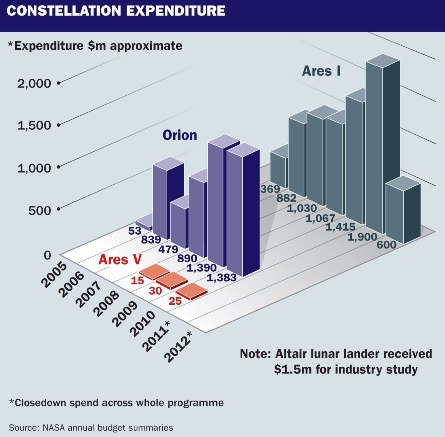President Barack Obama’s 2011 budget has ended NASA’s 2020 Moon programme while privatising manned spacecraft and proposing exploration that has goals but no destinations, incurring the wrath of politicians even before the agency has admitted that its first commercial cargo transportation project’s costs have jumped 60%.
For those in Congress who want to stop Obama's policy that replaces the 2020 Moon programme called Constellation with an exploration plan that has no destinations yet and privatised space transportation the news that NASA’s first foray into commercial cargo services has jumped from $500 million to $800 million will be good news.
Recognising the political dimension to exploration, Obama’s NASA administrator, former Space Shuttle astronaut Charles Bolden, told a 2 February press conference that there would be a “national debate” on those destinations and that special teams were already working on the missions’ requirements - he expected more detail in the coming weeks.
His deputy Lori Garver told a 1 February budget teleconference that the exploration plan’s goals were about developing technology to enable future exploration, not just destinations. One example is the five-year $3.1 billion propulsion development programme for a heavy lift rocket that could operate in the 2020s.
Constellation had a heavy lift rocket, the Ares V cargo launch vehicle. This was planned to have flown by the end of this decade to launch the Altair lunar lander and its Earth departure stage. On a Moon mission astronauts would have used the Orion crew exploration vehicle, launched by its Ares I crew launch vehicle rocket, to reach the orbiting EDS and Altair. The Ares I launched Orion would have also taken crews to the International Space Station. Once Orion docked with Altair the EDS would have sent them to the Moon.
 |
|---|
From 2005 to 2010 NASA spent about $9 billion on Ares I and Orion with some small funds for early Ares V and Altair development. Despite Obama's budget cancelling Constellation the programme's industrial contracts mean a further $2.5 billion will have to be spent to shut down the Moon return project completely. In explaining why it was cancelled Bolden described Constellation as "unsustainable" due to its expected high costs.
The astronauts that would have travelled on Constellation’s vehicles to reach the space station could now be carried by private transportation providers whose launch systems would be developed under a new $6 billion commercial crew programme. Obama’s fiscal year 2011 budget that starts on 1 October has $500 million for the new commercial programme, which Garver expects to see astronauts transported to ISS from 2016. NASA was unable to provide any more information on this programme but on 2 February Bolden said: “we’re departing from the model of the past. The commercial route is to leverage private investment to reduce the development cost to the taxpayer”.
The Obama plan has not been well received by Republican and Democratic party senators and congressmen in the space programme states of Florida, Texas, Alabama and Utah. And, under the FY2010 budget appropriations act passed in December 2009 Congress has to approve Constellation’s cancellation.
Last week Democratic senator for Florida Bill Nelson quoted the famous Apollo 13 misqoute, “Houston, we have a problem” - and called a 24 February hearing on the matter. A 3 February Congressional hearing had already been planned before budget was published. Republican Senator Richard Shelby for Alabama, where NASA has its main rocket design site, is opposed to any change and says: “Constellation is the only path forward that maintains America’s leadership in space.” However, Nelson admitted in his 1 February teleconference that it would be difficult to get enough votes to stop Constellation’s cancellation.
But Congress must approve all funding and Constellation was fatally wounded by year-after-year cuts from Republican-dominated legislative chambers despite the programme being the creation of their party’s president George W. Bush.
And now NASA is sinking an extra $300 million into its first commercial transportation programme, for cargo. Started in 2006 to enable cargo delivery to the ISS by 2011, the development phase, called Commercial Orbital Transportation Services, or COTS, had $500 million to be matched in part by NASA’s commercial partners, Space Exploration Technologies and initially Rocketplane Kistler, which was replaced by Orbital Sciences.
The second phase, the $3.5 billion commercial resupply contract, was awarded in 2008 to the COTS companies SpaceX and Orbital. The extra FY2011 budget funds could be explained by initial delivery payments under that resupply contract but neither of these two companies nor NASA would comment further on the dramatic budget change. Its not the first boost for the COTS companies, either; they both benefitted from $24 million in extra funds under Obama’s 2009 American Recovery and Reinvestment act.
With Bolden investing confident rhetoric in the privatisation of space transport the 60% hike for COTS demonstrates that it is not a path without difficulty. When Constellation was in its early days the then-new NASA administrator Michael Griffin said the biggest challenge for the programme was the transition between administrations. Constellation failed that challenge but Obama’s vision could founder before it has even begun.
NASA FY2011 budget: Key Points |
|---|
Source: Flight International



















